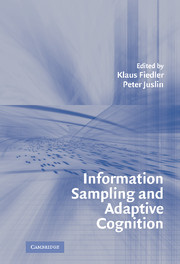Book contents
- Frontmatter
- Contents
- List of Contributors
- PART I INTRODUCTION
- PART II THE PSYCHOLOGICAL LAW OF LARGE NUMBERS
- PART III BIASED AND UNBIASED JUDGMENTS FROM BIASED SAMPLES
- PART IV WHAT INFORMATION CONTENTS ARE SAMPLED?
- 11 What's in a Sample? A Manual for Building Cognitive Theories
- 12 Assessing Evidential Support in Uncertain Environments
- 13 Information Sampling in Group Decision Making: Sampling Biases and Their Consequences
- 14 Confidence in Aggregation of Opinions from Multiple Sources
- 15 Self as Sample
- PART V VICISSITUDES OF SAMPLING IN THE RESEARCHER'S MIND AND METHOD
- Index
- References
12 - Assessing Evidential Support in Uncertain Environments
Published online by Cambridge University Press: 02 February 2010
- Frontmatter
- Contents
- List of Contributors
- PART I INTRODUCTION
- PART II THE PSYCHOLOGICAL LAW OF LARGE NUMBERS
- PART III BIASED AND UNBIASED JUDGMENTS FROM BIASED SAMPLES
- PART IV WHAT INFORMATION CONTENTS ARE SAMPLED?
- 11 What's in a Sample? A Manual for Building Cognitive Theories
- 12 Assessing Evidential Support in Uncertain Environments
- 13 Information Sampling in Group Decision Making: Sampling Biases and Their Consequences
- 14 Confidence in Aggregation of Opinions from Multiple Sources
- 15 Self as Sample
- PART V VICISSITUDES OF SAMPLING IN THE RESEARCHER'S MIND AND METHOD
- Index
- References
Summary
In this chapter, we explore a classic problem in psychology: How do individuals draw on their previous experience in an uncertain environment to make a prediction or diagnosis on the basis of a set of informational cues? Intuitive predictions based on multiple cues are often highly sensitive to environmental contingencies yet at the same time often exhibit pronounced and consistent biases.
Our research has focused on judgments of the probability of an outcome based on binary cues (e.g., present/absent), in which the diagnostic value of those cues has been learned from direct experience in an uncertain environment. For example, in medical diagnosis, we might predict which disease a patient has based on a symptom that a patient does or does not exhibit. We have developed a model that captures both the strengths and weaknesses of intuitive judgments of this kind (the Evidential Support Accumulation Model, ESAM; Koehler, White, & Grondin, 2003). The model assumes that the frequency with which each cue is observed to have co-occurred with the outcome variable of interest is stored. The perceived diagnostic value of each cue, based on these frequencies, is calculated in a normatively appropriate fashion and integrated with the prior probability of the outcome to arrive at a final probability judgment for a given outcome.
ESAM is designed to account for people's behavior in uncertain environments created in the lab that are, effectively by definition, sampled without bias.
- Type
- Chapter
- Information
- Information Sampling and Adaptive Cognition , pp. 261 - 298Publisher: Cambridge University PressPrint publication year: 2005
References
- 1
- Cited by



